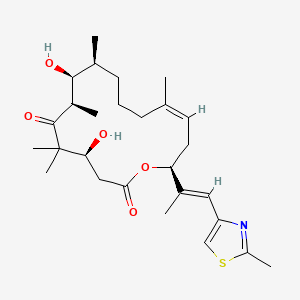
|
Epothilone D |
Epothilone d is a lipid of Polyketides (PK) class. Epothilone d is associated with abnormalities such as Tauopathies, Neutropenia, Neuropathy and Hematological Disease. The involved functions are known as Mutation, Apoptosis, Mitotic arrest, Cell Growth and Anabolism. Epothilone d often locates in Cytoskeleton, Axon, Cell Wall, Chromosomes and Spindle. The associated genes with epothilone D are SLC33A1 gene, Chromatin, GTF2I gene and HEXA gene. |
174 |
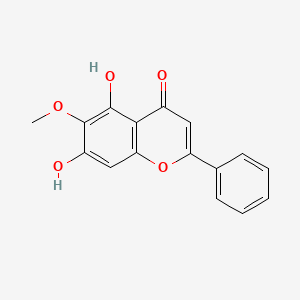
|
Oroxylin A |
Oroxylin A is a lipid of Polyketides (PK) class. |
180 |
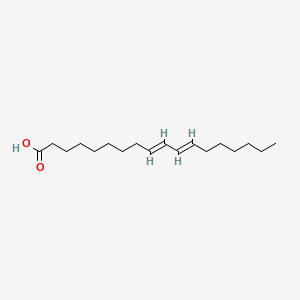
|
9,11-octadecadienoic acid |
9,11-octadecadienoic acid is a lipid of Fatty Acyls (FA) class. |
194 |
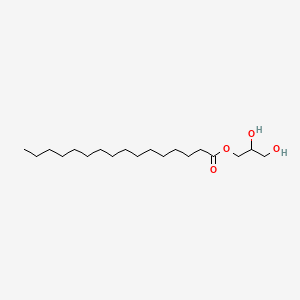
|
1-Palmitoyl-rac-glycerol |
1-Palmitoyl-rac-glycerol is a lipid of Glycerolipids (GL) class. 1-palmitoyl-rac-glycerol is associated with abnormalities such as Eczema, Food Allergy and Fatty Liver. The involved functions are known as inhibitors, lysophospholipase activity, Adjudication, cell transformation and Detergents. 1-palmitoyl-rac-glycerol often locates in Cytosol and soluble fraction. The associated genes with 1-Palmitoyl-rac-glycerol are FASTK Gene. The related lipids are 1,2-oleoylphosphatidylcholine, Lysophospholipids, phenyl valerate, Lysophosphatidylcholines and Palmitates. |
197 |
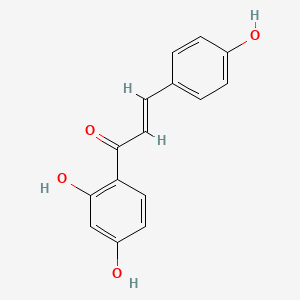
|
isoliquiritigenin |
Isoliquiritigenin is a lipid of Polyketides (PK) class. Isoliquiritigenin is associated with abnormalities such as abnormal fragmented structure, Gastric ulcer, Gastric mucosa lesion, Peptic Ulcer and Wiskott-Aldrich Syndrome. The involved functions are known as Mass-to-Charge Ratio, Anabolism, Oxidation, inhibitors and Energy Absorption. Isoliquiritigenin often locates in Microsomes, Liver, Hepatic, Microsomes, Immune system and Vacuole. The associated genes with Isoliquiritigenin are P4HTM gene, BCL2 gene, AP1AR gene, oxytocin, 1-desamino-(O-Et-Tyr)(2)- and ODAM gene. The related experimental models are Knock-out. |
220 |
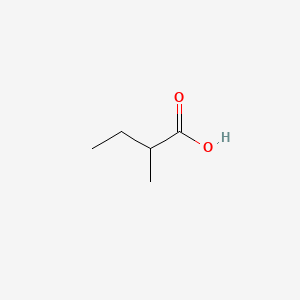
|
2-Methylbutanoic acid |
2-Methylbutanoic acid is a lipid of Fatty Acyls (FA) class. The involved functions are known as Binding (Molecular Function), Oxidation, isoleucine catabolic process, Anabolism and physiological aspects. 2-methylbutanoic acid often locates in Membrane, soluble and host. The associated genes with 2-Methylbutanoic acid are Homologous Gene, Genome, NKS1 gene, HM13 gene and ACSM1 gene. The related lipids are Fatty Acids, Butyric Acids, branched chain fatty acid, Propionate and 2-methylvalerate. |
222 |
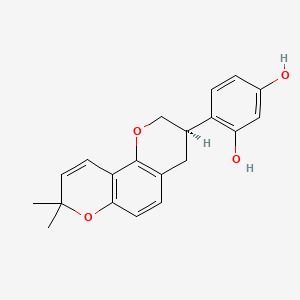
|
Glabridin |
Glabridin is a lipid of Polyketides (PK) class. Glabridin is associated with abnormalities such as Atherosclerosis, CNS disorder, Corn of toe, Fatty Liver and Obesity. The involved functions are known as Energy Absorption, Oxidation, Oxidants, Metabolic Process, Cellular and Drug Interactions. Glabridin often locates in Hepatic, membrane fraction, Microsomes, Microsomes, Liver and Extracellular. The associated genes with Glabridin are P4HTM gene, SPEN gene, SLC33A1 gene, ABCB1 gene and CD9 gene. The related lipids are Nonesterified Fatty Acids, Total cholesterol, Lipopolysaccharides, Hydroxycholesterols and 7-ketocholesterol. The related experimental models are Mouse Model. |
263 |
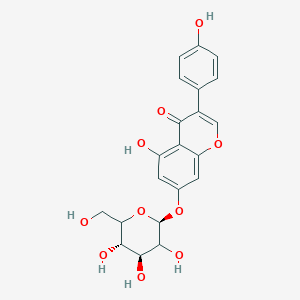
|
genistein 7-O-glucoside |
genistein 7-O-glucoside is a lipid of Polyketides (PK) class. Genistein 7-o-glucoside is associated with abnormalities such as athymia, Heart Diseases, Thyroid Diseases, Plague and Brucella infections. The involved functions are known as Cell Proliferation, Binding (Molecular Function), Ingestion, topoisomerase activity and kinase activity. Genistein 7-o-glucoside often locates in Membrane, Gastrointestinal tract structure, Oral region, Body tissue and Blood. The associated genes with genistein 7-O-glucoside are GLUCOSIDASE, PPP1R1A gene, Homologous Gene, Genome and FUSE gene. The related lipids are Sterols, 1,2-oleoylphosphatidylcholine, Membrane Lipids and DOPE. |
264 |
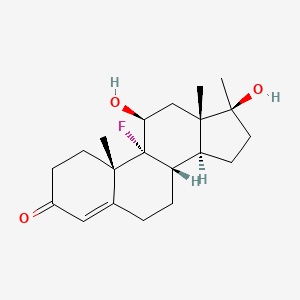
|
Fluoxymesterone |
Fluoxymesterone is a lipid of Sterol Lipids (ST) class. Fluoxymesterone is associated with abnormalities such as Anemia. The involved functions are known as Stimulus. Fluoxymesterone often locates in Entire bony skeleton. |
280 |
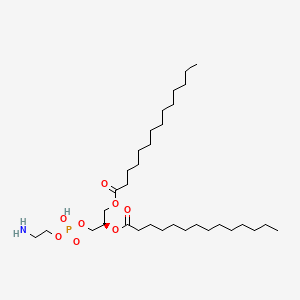
|
998-07-2 |
998-07-2 is a lipid of Glycerophospholipids (GP) class. 998-07-2 is associated with abnormalities such as Abnormal shape, Influenza, Cardiovascular Diseases, Rheumatoid Arthritis and Morphologically altered structure. The involved functions are known as Pressure- physical agent, Physiologic Organization, Process, Drug Interactions and Baresthesia. 998-07-2 often locates in I band, Membrane, Lipid Bilayers, Head and Tissue membrane. The associated genes with 998-07-2 are ATR gene, Fusion Protein and ADRBK1 gene. The related lipids are dimyristoylphosphatidylglycerol, 1,2-dimyristoylphosphatidylethanolamine, 1,2-oleoylphosphatidylcholine, Octanols and Membrane Lipids. |
283 |

|
(-)-Perillyl alcohol |
(-)-perillyl alcohol is a lipid of Prenol Lipids (PR) class. The involved functions are known as Cell Cycle Progression, Cell Cycle, Cell Proliferation, Apoptosis and Isoprenylation. (-)-perillyl alcohol often locates in Cytoplasm, Membrane and Plasma membrane. The associated genes with (-)-Perillyl alcohol are JUN gene, Candidate Disease Gene, IL24 gene, BCL2L1 gene and CFB gene. The related experimental models are Transgenic Model. |
299 |

|
Quercetin 3-beta-D-glucoside |
Quercetin 3-alloside is a lipid of Polyketides (PK) class. Quercetin 3-alloside is associated with abnormalities such as Vitelliform dystrophy. The involved functions are known as sugar binding and Docking. |
319 |

|
Quercetin 3-beta-D-glucoside |
Quercetin 3-alloside is a lipid of Polyketides (PK) class. Quercetin 3-alloside is associated with abnormalities such as Vitelliform dystrophy. The involved functions are known as sugar binding and Docking. |
319 |
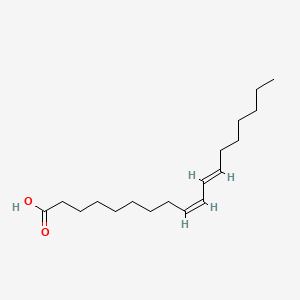
|
Rumenic acid |
Rumenic acid is a lipid of Fatty Acyls (FA) class. Rumenic acid is associated with abnormalities such as Atherosclerosis, Vascular lesions, Hyperlipidemia and Consumption-archaic term for TB. The involved functions are known as Fatty streaks, Transcriptional Activation, Atherogenesis, cholesterol transport and ATP binding. Rumenic acid often locates in Blood and Body tissue. The associated genes with Rumenic acid are ABCA1 gene, apolipoprotein SAA, FATE1 gene and TFCP2 gene. The related lipids are 9,11-linoleic acid, (E,Z)-isomer, 9,11-linoleic acid, Fatty Acids, 11-octadecenoic acid and Total cholesterol. |
324 |

|
29623-28-7 |
29623-28-7 is a lipid of Fatty Acyls (FA) class. |
324 |
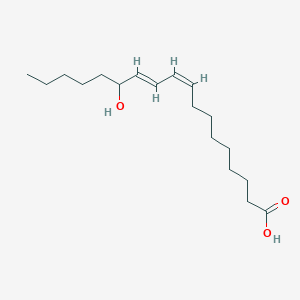
|
Coriolic acid |
Coriolic acid is a lipid of Fatty Acyls (FA) class. The involved functions are known as Autoimmunity, Autoimmune, T-cell differentiation, Binding (Molecular Function) and T-Cell Activation. The associated genes with Coriolic acid are IL2 gene. The related lipids are 9-hydroxy-10,12-octadecadienoic acid, hydroxy fatty acid and octadecadienoic acid. |
326 |

|
L-norvaline |
L-norvaline is a lipid of Fatty Acyls (FA) class. L-norvaline is associated with abnormalities such as Celiac Disease, Exanthema, Atherosclerosis, Plasmodium falciparum infection and Parasitemia. The involved functions are known as Anabolism, Saturated, Stimulus, Physiologic Organization and arginase activity. L-norvaline often locates in Extracellular, Protoplasm, soluble, viral nucleocapsid location and Cell Wall. The associated genes with L-norvaline are norvaline, Amino Acids, Basic, ARG1 gene, Escherichia coli Proteins and Operon. The related lipids are Lipopolysaccharides. |
328 |
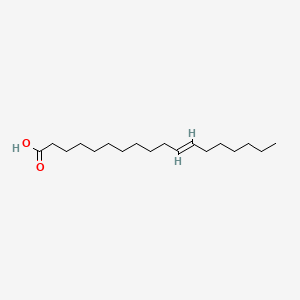
|
trans-vaccenic acid |
Trans-vaccenic acid is a lipid of Fatty Acyls (FA) class. |
341 |

|
Crocetin |
Crocetin is a lipid of Prenol Lipids (PR) class. Crocetin is associated with abnormalities such as abnormal fragmented structure, Gout, Infection and athymia. The involved functions are known as Cytokinesis, Anabolism, enzyme mechanism, Pathological accumulation of air in tissues and Hemorrhage. Crocetin often locates in Vacuole, Cytoplasmic matrix, Body tissue, Mitochondria and Blood. The associated genes with Crocetin are cytochrome c'', BCL2 gene and PCNA gene. The related lipids are mycorradicin. |
350 |
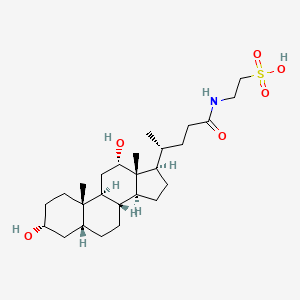
|
Taurodeoxycholic acid |
Taurodeoxycholic acid is a lipid of Sterol Lipids (ST) class. Taurodeoxycholic acid is associated with abnormalities such as Ischemia and Wiskott-Aldrich Syndrome. The involved functions are known as Cell Proliferation, Transcriptional Activation, Phosphorylation, Anabolism and Biochemical Pathway. Taurodeoxycholic acid often locates in Body tissue, Epithelium, Blood, Mucous Membrane and Hepatic. The associated genes with Taurodeoxycholic acid are NOX5 gene, GPBAR1 gene, NR1H4 gene and SLC33A1 gene. The related lipids are cholanic acid, taurolithocholic acid 3-sulfate, Sterols, 7-dehydrocholesterol and tauromuricholic acid. |
352 |



















